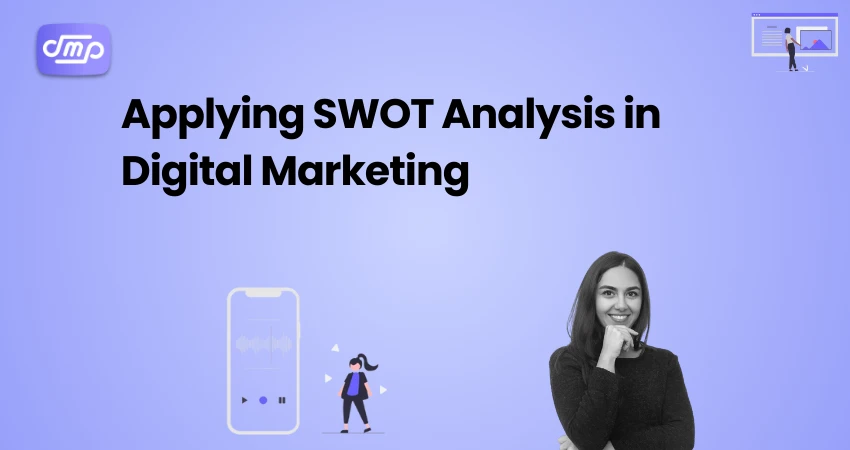
- September 16, 2025
- Digital Marketing, seo
- Digital Marketing
Table of Contents
Businesses can no longer compete by relying on guesswork in the fast-paced online environment of today. Having a clear plan is crucial because of the increasing competition and the ever-changing preferences of customers. SWOT analysis is one of the best techniques for developing a plan in digital marketing. This framework aids marketers in recognizing their advantages, strengthening their disadvantages, seizing fresh possibilities, and becoming ready for possible dangers. You can obtain important insights that help you make better decisions, boost performance, and offer your company a competitive edge by incorporating SWOT Analysis into your digital marketing initiatives.
What is SWOT Analysis in Digital Marketing?
In digital marketing, SWOT analysis is a potent strategic framework that aids companies in assessing where they are in the online market right now. It gives marketers a clear picture of where they stand and how to proceed by concentrating on four areas: strengths, weaknesses, opportunities, and threats. In contrast to relying just on intuition, SWOT offers a methodical and data-driven approach to campaign planning, performance optimization, and maintaining competitiveness in the ever-evolving digital market.
Strengths are a brand’s inherent benefits, such as high brand awareness, successful SEO, devoted clientele, or an active social media presence. Conversely, weaknesses draw attention to the areas that require development, such as a sluggish website, poor conversion rates, or constrained expenditures that limit the reach of a campaign. Opportunities are outside forces that have the potential to spur expansion, including new social media platforms, developments in artificial intelligence tools, or untapped market niches. Threats, on the other hand, are difficulties brought on by external factors, such as changes to search engine algorithms, growing ad prices, or heightened industry competition.
Businesses can obtain a comprehensive understanding of their digital marketing effectiveness by examining these four elements. More significantly, it enables them to capitalize on their advantages, improve their shortcomings, take advantage of chances for development, and get ready for any risks. To put it briefly, SWOT analysis in digital marketing serves as a road map that aids companies in developing more intelligent plans and achieving sustained success in the cutthroat digital landscape.
Breaking Down SWOT Analysis in Digital Marketing

It is evident how each component helps to create a solid strategy when we dissect SWOT analysis in digital marketing. Internal advantages, such as a well-known online presence, devoted clientele, or SEO operations that constantly generate traffic, are what make a business stand out in the digital sphere. By identifying these assets, marketers may optimize impact and improve on what is currently effective.
Conversely, weaknesses highlight the internal issues that are preventing a company from growing. Slow website performance, erratic social media activity, low interaction rates, or a small advertising budget are a few examples. Because weak foundations can cause even strong campaigns to fail, it is imperative to address shortcomings.
External elements that have the potential to accelerate growth are typically the source of opportunities in digital marketing. These might be new platforms, tools driven by artificial intelligence, changing customer habits, or opportunities to enter new markets. Businesses can swiftly adjust and outperform slower rivals by becoming aware of these chances.
Threats are outside dangers that have the potential to impair digital performance. These frequently include increased competition, shifting search engine algorithms, rising ad prices, or bad press that damages a brand’s reputation. Businesses can create defensive mechanisms and maintain resilience if these dangers are identified early.
Businesses gain a fair viewpoint when SWOT analysis is broken down in digital marketing. It draws attention to what is effective, identifies areas of weakness, identifies fresh opportunities for development, and aids in foreseeing difficulties. This all-encompassing perspective is what makes SWOT such a useful framework for marketers looking to create long-term, sustainable plans.
How to Apply SWOT Analysis in Digital Marketing
Getting accurate information about the online performance of your brand is the first step in using SWOT analysis in digital marketing. Looking inward and determining your strengths and limitations is the first step. This entails examining data like email campaign performance, social media engagement, conversion rates, website traffic, and keyword rankings. Discovering what’s causing success and what needs work can be aided by tools such as Google Analytics, SEMrush, and social insights. Being honest and truthful at this point is crucial since failing to see flaws or exaggerating strengths might produce false outcomes.
Assessing external elements that affect your marketing is the next stage after determining the internal factors. Technological advancements, changing consumer preferences, and industry changes frequently present opportunities. For instance, the emergence of AI-powered personalization tools or short-form video platforms may make it easier for companies to engage with consumers. Threats, such as increased competition, frequent changes to search engine algorithms, or growing expenses for online advertising, also need to be closely watched.
Once all four SWOT elements have been identified, the true value lies in putting findings into practice. This entails utilizing strengths to take advantage of opportunities, minimizing dangers, and resolving weaknesses with focused enhancements. For example, social advertising combined with customized landing pages might provide balance if your business has a large social media following but low website conversions. Your ability to retain customers could be leveraged to strengthen retention measures if a new competitor is threatening your market share.
In the end, using SWOT analysis in digital marketing is a continuous activity rather than a one-time event. Businesses that routinely review their SWOT analysis are better able to modify their strategy, maintain their competitiveness, and achieve steady growth in the ever-evolving digital landscape. Marketing professionals may make sure that every campaign is based on clarity, adaptability, and long-term vision by coordinating SWOT insights with overarching business objectives.
Turning SWOT Insights into Strategy
Finding strengths, weaknesses, opportunities, and threats is only one aspect of SWOT analysis’s real value in digital marketing; another is turning those findings into workable plans. Many companies halt at the analysis phase, compiling a list of findings without putting them into practice. SWOT analysis must have a direct impact on your digital marketing initiatives and decisions in order to be successful.
Aligning your strengths with the opportunities that are accessible is one approach to achieve this. For instance, you can optimize your content for voice inquiries to reach a wider audience if your company already has a high SEO authority and voice search is becoming more popular. Weaknesses should be addressed concurrently by creating plans that stop them from impeding development. Investing in performance optimization guarantees that campaign traffic is not wasted if your website is sluggish and influencing conversions.
Utilizing strengths to lessen the impact of dangers is an additional strategy. For example, a devoted clientele might serve as a defense against hostile rivals or unfavorable press. In a similar vein, possibilities can be leveraged to offset weaknesses. For instance, a small marketing team can compensate for limited resources by managing large-scale campaigns more effectively by implementing new AI-driven solutions.
Setting priorities is another aspect of converting SWOT analysis into a strategy. It’s critical to concentrate on the elements that directly affect your objectives, whether they be raising brand awareness, conversions, or client retention, as not all of the points in your SWOT analysis will be equally important. Businesses can develop precise, quantifiable, and implementable plans that produce outcomes by aligning SWOT elements with certain goals.
Conclusion
Understanding your company’s current state is as crucial in the rapidly evolving world of internet marketing as the campaigns you conduct. By emphasizing strengths to build upon, weaknesses to strengthen, chances to take advantage of, and dangers to be ready for, SWOT analysis in digital marketing offers that clarity. It is more than just a planning framework; it is a useful manual for deciding wisely, improving tactics, and outperforming rivals.
Applying SWOT consistently turns it from a straightforward analysis into a potent growth plan. It guarantees that all digital marketing initiatives, including paid advertisements, social media, email campaigns, and SEO, are supported by facts rather than conjecture. You may overcome obstacles, quickly adjust to new trends, and succeed over the long term in the digital sphere by periodically reviewing and upgrading your SWOT analysis.











